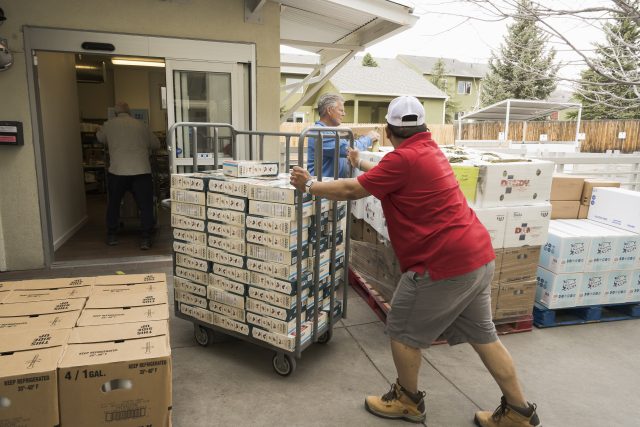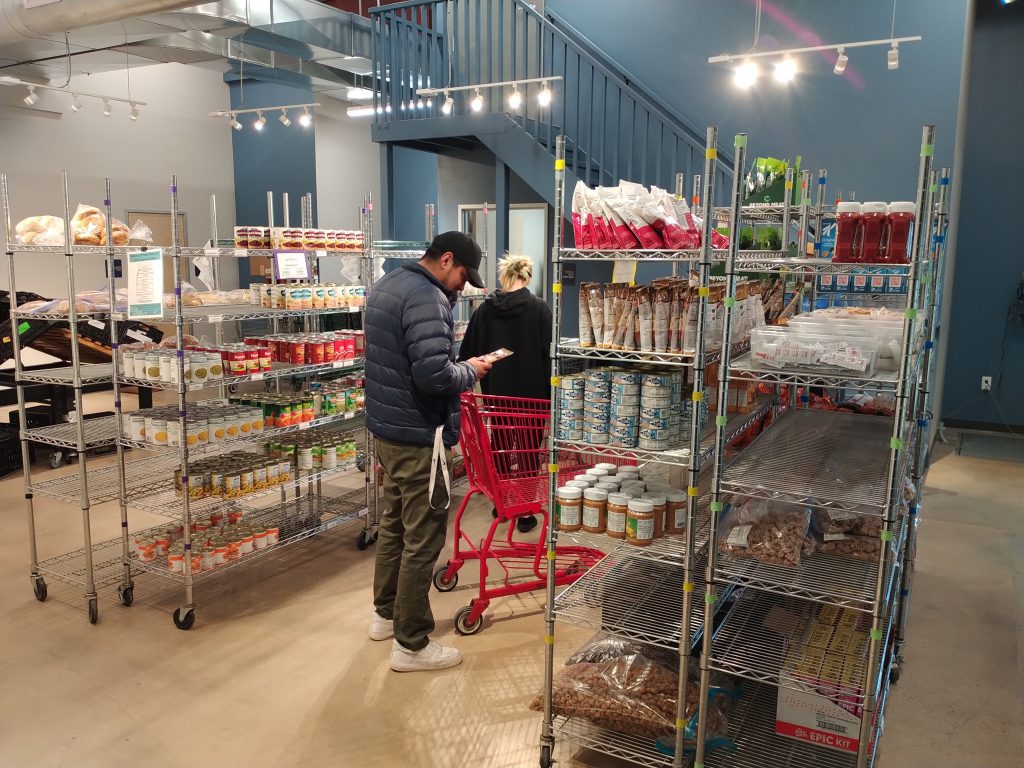
Carolyn Drews has volunteered at the Emergency Family Assistance Association (EFAA) food bank for two years. The shelves have always been full. Recently, that’s changed.
During a shift in March, Drews noticed something unusual — there wasn’t any tuna, which is usually always available. She also noticed less personal care supplies like shampoo and toilet paper.
“During the pandemic it seemed like there was plenty of food and personal care items,” she says. “So very suddenly things have changed.”
Variability is built into food banks, especially ones like EFAA that rely mostly on donations. But these days, Walter O’Toole, food bank manager at EFAA, calls it “extreme.”
“Day by day it’s a struggle to get enough food to distribute,” he says.
The food bank has seen an increase in visitors over the last few years. In March 2021, it was serving 219 people a week. By March 2023, that number jumped to 636.
“That’s super concerning,” says O’Toole, who expects those numbers to increase. “From the manager standpoint, it’s like how much of this need can I meet? I want to meet it all, but I know I’m not even doing that right now.”
EFAA isn’t alone — food banks and pantries across the county are seeing a spike in visitors.
Harvest of Hope Pantry has programs for clients both with and without kitchens. The organization’s with-kitchens program saw more than twice as many new clients in March and April as it did in January and February.
Community Food Share (CFS) enrolled 180 new families in its programming in March, which is above its monthly average of 139 since last July. March also marked the highest total visits at CFS since the earliest recorded data in July 2019.
“[The numbers are] concerning, and especially because we don’t expect it to slow down,” says Trevor Bosetti, senior marketing manager at CFS.
Food bank employees offered a number of factors for the rise in demand, like the cost of housing, childcare and inflation. In addition, pandemic-era programs have ended, or will soon come to an end, leaving a gap in support. But it seems the end of maximum Supplemental Nutrition Assistance Program (SNAP) benefits were key in triggering the latest surge in need.
With less social support programs available and more people relying on food banks, staff wonder how they will keep up with demand.

EFAA’s food bank served 636 people a week in March 2023, compared to 219 in 2021. Credit: Chris Nichols
Hitting a pinch
At the end of February, the federal government decreased the pandemic-spawned maximum allotment of SNAP benefits. For an average family, those changes meant about $90 less a month per person enrolled in the program. A larger family could experience $360 less per month in food assistance.
In Boulder County, there are 20,000 people receiving food assistance from SNAP. Since maximum SNAP allotments changed, there’s $53 million less going to Colorado residents statewide each month.
Simultaneously, prices and cost of living remain high. The U.S. Bureau of Labor Statistics found the Consumer Price Index for food was at 8.5% in March 2023 after being as high as 13.5% in mid 2022 — meaning higher prices for staples like bananas, bread, chicken and eggs.
But it’s not just people eligible for SNAP benefits who are struggling to make ends meet. Colorado Center on Law and Policy’s (CCLP) latest Overlooked and Undercounted 2022 report found nearly 25% of working families in Colorado did not earn enough income in 2019 to cover basic needs including food, housing and transportation. The report found most of these households are above income thresholds that would qualify for public assistance programs like SNAP.
Food banks serve people in many different circumstances. When Ellen Ross, communications manager at EFAA, volunteered at the food bank, she met a chef at a local restaurant who had shoulder surgery, but didn’t have paid leave. He needed to supplement food costs until he could be fully functional and back to work.
“For so many, sometimes it’s just an episode that has occurred in their life, and they just need the help for this little stamp of time,” she says.
Charlie Brennan, deputy director of research at CCLP, says families often cut their food budgets because it isn’t a fixed cost like rent, a mortgage or health insurance.
“[Families] are having to increasingly look to other areas of their budget to cut back on — food being one that might be easier, not only because it’s under their control, but also because there are food banks out there to help supplement those costs,” he says.
But food banks are scrambling to keep up with the increase of clients. The EFAA food bank has already seen nearly 5,000 unique individuals this fiscal year after serving about 3,500 in 2022 and just under 3,000 in 2021. With three months left to go this fiscal year, that’s already a 32% increase.
This demand culminates in people walking away with nearly 10 pounds less of food each trip compared to 2020, even as management moves money from personal care items to food, and seeks more grants for food purchasing.
At CFS, Bosetti is concerned about what he calls the “hunger cliff” — when demand increases so quickly that distribution can’t keep up. Like EFAA, he says CFS is already seeing this as families are visiting more often but walking away with less food each visit.
And it’s almost summer, a time when food banks typically see more visitors as families can’t rely on school meal programs for kids. Without additional support, there’s concern the chasm will grow wider.
“It’s a delicate time period at the moment,” says Bosetti.
Jen O’Neal, community food systems senior manager at Hunger Free Colorado, says food banks and pantries are “really hitting a pinch while the need for their services is the same if not higher” as COVID-19 emergency funds like maximum SNAP benefits, the childcare tax credit, and the CARES Act dry up.
O’Toole says when those supports ended, food banks and pantries were left to fill the gaps.
“Having those assistance programs slowly rolled back, and then seeing the needle move in the wrong direction, can be pretty frustrating because we are not able to provide that kind of support at that scale,” he says.
O’Neal says the problem isn’t unique to Colorado.
“I can say nationally, this is a really, really challenging time.”

Movement at the state
The Food Pantry Assistance Grant (FPAG) is one state-funded grant built to help fund food pantries in Colorado since 2018. Last year, $3 million was distributed through the grant compared to around $5 million the previous two years.
For the EFAA food bank, that meant a $75,000 difference in FPAG grant dollars between 2021 and 2022.
In response to the rising dependency on food programs, the state is expediting the process to distribute $4 million to food pantries through FPAG, which is part of $14 million in supplemental funding for food banks and food pantries this year.
FPAG isn’t written into the state budget, but Hunger Free Colorado is advocating to pass Senate Bill 23-27, which would allocate $3 million a year through 2027. This year’s grantees will be announced at the end of May.
“We’ve seen the government stepping up in ways that haven’t taken effect yet,” says Bosetti, with CFS, “but there is some hope that there will be some supplemental help there.”
Harvest of Hope Pantry started Tuesday evening hours at the beginning of April to reach more people, which Liam McClure, client programs manager at Harvest of Hope, calls a successful expansion so far. He says the pantry is not concerned about running out of food, but “may be slim on certain items at times.”
Community Food Share is applying for more grants at the state level, including FPAG, and has extended its Thursday hours to serve more people. Since that change, Bosetti’s seen more people attend in their scrubs or other work uniforms.
But without additional support, there’s only so much these community resources can do. While securing more grants increases food-buying capabilities, those grants require additional administrative work.
“When [policy solutions] roll through, that makes a difference and the outlook improves,” says O’Toole. “When policy solutions are not enacted, I have no reason to expect the situation will get any better.”














